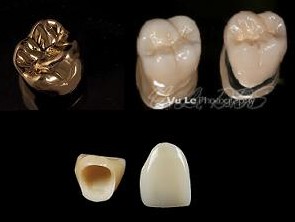Once root canal treatment has been performed then the tooth must be restored. Root canals are usually performed on teeth that are quite broken down and therefore must be built up to have enough tooth structure available to hold onto a crown. In order to retain the core buildup, many times a post must be placed inside the root canal.  This is done by removing a portion of the root canal filling material (the part closest to the tip of the root is left to seal the end) and drilling out the proper size to accept the post (no need to worry about the drilling – remember there is no nerve in a root canal tooth). Then, the dentist chooses one of two types – a cast post and core or a prefabricated post. The cast post and core has advantages in that the core buildup is made as one piece with the post so there is no way for the two to separate. A disadvantage is that it must be fabricated outside of the mouth and therefore cannot be cemented on the same day, however, other provisions must be made to build up the tooth. Some prefabricated posts are metal and some of the newer ones are made of carbon fiber composite. The newer carbon fiber ones have a little bit of give to them and they look promising on possibly reducing root fractures in teeth with posts.
This is done by removing a portion of the root canal filling material (the part closest to the tip of the root is left to seal the end) and drilling out the proper size to accept the post (no need to worry about the drilling – remember there is no nerve in a root canal tooth). Then, the dentist chooses one of two types – a cast post and core or a prefabricated post. The cast post and core has advantages in that the core buildup is made as one piece with the post so there is no way for the two to separate. A disadvantage is that it must be fabricated outside of the mouth and therefore cannot be cemented on the same day, however, other provisions must be made to build up the tooth. Some prefabricated posts are metal and some of the newer ones are made of carbon fiber composite. The newer carbon fiber ones have a little bit of give to them and they look promising on possibly reducing root fractures in teeth with posts.
Tag Archives: Crown
Crowns
Crowns or caps have had over a century of success in saving teeth. Fillings are used to restore tooth structure lost to decay or fractures, however, they do not cover and protect the teeth from fracturing like crowns do. There are three major varieties of crowns – cast metal, porcelain-fused-to-metal, and all porcelain.
Cast crowns are usually made of gold. They have the longest track record and usually last the longest of the group. This is because there is no veneering surface to fracture and gold is a very tough, inert substance. I have personally observed crowns that have been in patients’ mouths for well over fifty years. The drawback is that they look like gold teeth. The other two varieties have a porcelain outer layer. Porcelain can be constructed to almost perfectly mimic teeth. And the porcelain is extremely tough and color stable. There are still quite a few crowns that I placed over thirty years ago that still look as good now as they did on the day that I put them in. The porcelain is baked onto a metal or porcelain core. The metal can be made much thinner, so it is better for crowns for back teeth. The newer porcelain cores are having very promising results and are excellent for front teeth because light can be transmitted through it giving the crown a natural life-like luster.

